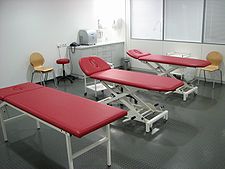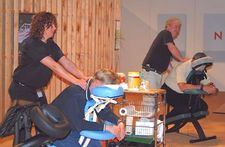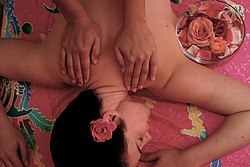Massage methods
Practitioners of massage include massage therapists, athletic trainers and physical therapists. Massage practitioners work in a variety of medical and recreational settings and may travel to private residences or businesses.[7] Contraindications to massage include deep vein thrombosis, bleeding disorders or taking blood thinners such as Warfarin, damaged blood vessels, weakened bones from cancer, osteoporosis, or fractures, bruising, and fever.[7]
[edit] Acupressure massage
Main article:
AcupressureAcupressure (a portmanteau of "acupuncture" and "pressure") is a traditional Chinese medicine (TCM) technique derived from acupuncture. With acupressure physical pressure is applied to acupuncture points by the hand, elbow, or with various devices.
[edit] Anma massage
Anma is a traditional Japanese massage involving kneading and deep tissue work.
[edit] Ayurvedic massage
Ayurveda is a natural health care system originating in India that incorporates massage, yoga, meditation and herbal remedies. Ayurvedic massage, also known as Abhyanga is usually performed by one or two therapists using a heated blend of herbal oils based on the ayurvedic system of humors.
[edit] Balinese massage
Balinese massage techniques are gentle and aim to make the patient feel relaxed and calm throughout. The techniques include skin folding, kneading, stroking,and other techniques. The massage therapist applies aromatheraphy oil throughout the massage. A patient's blood, oxygen and energy flow is said to increase as a result of the treatment.[citation needed] Balinese hot stones are an option.
Barefoot deep tissue, also known as barefoot compressive deep tissue, or barefoot sports massage, is a blend of Eastern barefoot techniques, such as barefoot Shiatsu massage, coupled with a Western manual medicine, encompassing deep tissue, myofascial release, trigger point therapy, transverse friction, compression, tension, shear, PNF, stretching, as well as parasympathetic response, on clothed clients using no oil. Dara Torres, 41-year old Olympian, received barefoot compression massage on a daily basis in her training program.[20]
This modality typically uses the heel, sesamoid, arch and/or whole plantar surface of foot, and offers large compression, tension and shear forces with less pressure than elbow or thumb, and is ideal for large muscles, such as in thigh, or for long-duration upper trapezius compressions.[21] The unclothed cousins of this modality are Keralite, Yumeiho, Barefoot Lomi Lomi, Fijian Barefoot, Chavutti Thirummal.
Ashiatsu Oriental Bar Therapy, which is a form of barefoot effleurage, combines western science and contemporary American ingenuity, for therapists who specialize in deep tissue work using Swedish techniques performed by the massage therapists feet.
Bowen therapy massage
Bowen technique involves a rolling movement over fascia, muscles, ligaments, tendons and joints. It is said not to involve deep or prolonged contact with muscle tissues as in most kinds of massage, but claims to relieve muscle tensions and strains and to restore normal lymphatic flow. It is based on practices developed by Australian Tom Bowen.[22]
Breema massage
Breema bodywork is performed on the floor with the recipient fully clothed. It consists of rhythmical and gentle leans and stretches.
Champissage massage
Main article:
ChampissageChampissage is a massage technique focusing on the head, neck and face that is believed to balance the chakras






